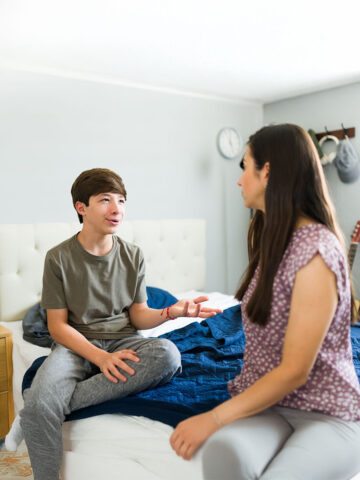By Dr. Julieta Aguilera Vazquez, pediatric psychologist at CHOC
Separation anxiety is a general term used to describe the worry or fear a person experiences when apart from caregivers, family members or other loved ones. Separation Anxiety is common in early childhood and typically self-resolves as the child develops, usually at around age 2 or 3.
Separation anxiety disorder (SAD) is a mental health diagnosis consisting of extreme fear of separation from home or caregivers and other loved ones. SAD happens most commonly in childhood but can also be present in adolescence and into adulthood. Common symptoms are frequent and recurring worries about being away from family members, family members getting into serious accidents, being abandoned, or forgotten by caregivers or other loved ones.
What are the symptoms of SAD at different stages of development?
While some anxiety during childhood and adolescence is completely typical and expected, children with SAD experience worry and anxiety that is more severe, persistent and impacts their daily lives.
For instance, children and teenagers who experience SAD may not be able to concentrate in school for fear that their parents may be in danger, they may call or message multiple times per day to ensure their family is safe or they may decline invitations to socialize so they can be by their family’s side. SAD may also present in different ways depending on the child’s age:
Young children (ages 8 months to 3 years)
Separation anxiety in young children is common and a part of development. Separation anxiety usually begins at about 8 months and manifests as fear and crying when around strangers or away from caregivers.
By age 2, toddlers begin to understand that even though their parents leave they will eventually return. However, when separation anxiety becomes more persistent and severe, this becomes a mental health concern and families may benefit from a consultation with a mental health provider.
Common symptoms of SAD include:
- Excessive clinging to caregivers or loved ones.
- Excessive tantrums when apart from caregivers.
- Fear and panic when their caregivers leave the room or shared space.
- Significant difficulty calming down after a caregiver has left.
Pre-schoolers and school-aged children (ages 4-10)
- Excessive worry when apart from home or the family.
- Excessive worry about the safety of a family member.
- Panic, fear and crying at the time of separation.
- Anticipatory anxiety about the separation – such as a child expressing fear or worry about the upcoming separation.
- Worry about being lost, kidnapped or family members having severe accidents.
- School refusal or avoidance so that the child can check on the safety of their family.
- Avoids attending sleepovers, parties or other events that will entail being away from home on the family.
- Difficulty concentrating in school due to separation worries.
- Refusal to sleep alone.
- Repeated nightmares with a theme of separation.
Tweens and teenagers (ages 11-18)
- Stomachaches, headaches and other physical symptoms that occur when the youth knows they will be away or are away from loved ones.
- Expressed anxiety about being away from loved ones.
- Panic attacks.
- Asking to sleep with loved ones.
- Difficulty sleeping alone.
- School avoidance or refusal.
- Avoiding after school activities, social gatherings, sleepovers, and any other social activities that may mean time away from home.
- Checking behaviors such as frequent texting or phone calls to loved ones to make sure they’re safe or to check their location.

Mental Health Education Program (MHEP) webinars
Tips and strategies for supporting your children with separation anxiety
- Allow your child to express their feelings and/or support the development of feelings vocabulary such as, “It sounds like you’re feeling anxious, worried, scared, etc.”
- Help your child identify and practice coping skills – such as mindfulness, deep breathing, muscle relaxation – they can use if they experience anxiety (see resources below or consult CHOC’s website for coping skills suggestions)
- Set consistent routines and expectations and discuss them with your child. For instance: “You will go to school, and I will go to work, and I will see you in the evening when we get back.”
- Make goodbyes quick and remain calm even if your child experiences dysregulation. It will be tempting to do so but DO NOT linger during goodbyes as this will likely reinforce your child’s anxiety
- Practice being apart – begin with smaller separations and work your way towards bigger ones. Remind your child that everything was OK after reunification and praise your child for how well they did while you were away.
Get more tips for helping your toddler cope with separation anxiety
Key points about separation anxiety disorder
While some separation anxiety during childhood and adolescence is a normal part of development, worry and anxiety that is more severe, persistent, and impacts youth’s daily lives may indicate the development of SAD.
SAD can present differently depending on the age of your child, however SAD typically involves the experience of significant fear and worry elicited by being away from a caregiver or loved one. If you are concerned that your child is at risk of developing SAD or has displayed symptoms of SAD, seek support from a mental health professional for further evaluation.
Recommended books and resources:
- Wherever You’ll Be by Ariella Prince Guttman
- Hand to Hold by JJ Heller
- Llama Llama Misses Mama by Anna Dewdney
- First Day Critter Jitters by Jory John
- The Yes Brain: How to Cultivate Courage, Curiosity, and Resilience in Your Child by Daniel J. Siegel, Tina Payne Bryson
- Parenting Your Anxious Child with Mindfulness and Acceptance: A Powerful New Approach to Overcoming Fear, Panic, and Worry Using Acceptance and Commitment Therapy by Christopher McCurry, Steven C. Hayes
- The Joy of Parenting: An Acceptance and Commitment Therapy Guide to Effective Parenting in the Early Years Paperback by Lisa W. Coyne, Amy R. Murrell
Get more expert health advice delivered to your inbox monthly by subscribing to the KidsHealth newsletter here.
Get mental health resources from CHOC pediatric experts
The mental health team at CHOC curated the following resources on mental health topics common to kids and teens, such as depression, anxiety, suicide prevention and more.





